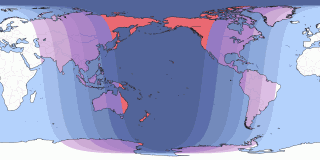Mar 3, 2026 at 5:33 am
Max View in 44°26'21.9"N, 100°14'01.4"W
| Global Event: | Total Lunar Eclipse |
|---|---|
| Local Type: | Total Lunar Eclipse, in 44°26'21.9"N, 100°14'01.4"W |
| Begins: | Tue, Mar 3, 2026 at 2:44 am |
| Maximum: | Tue, Mar 3, 2026 at 5:33 am 1.150 Magnitude |
| Ends: | Tue, Mar 3, 2026 at 7:18 am |
| Duration: | 4 hours, 34 minutes | All times shown on this page are local time. |
Eclipses and Transits Visible in 44°26'21.9"N, 100°14'01.4"W
| Eclipse Visibility From 44°26'21.9"N, 100°14'01.4"W | Visibility Worldwide | ||
|---|---|---|---|
| Mar 13–14, 2025 Total Lunar Eclipse | Total Lunar Eclipse |  | |
| Mar 3, 2026 Total Lunar Eclipse | Total Lunar Eclipse |  | |
| Aug 27–28, 2026 Partial Lunar Eclipse | Partial Lunar Eclipse |  | |
| Feb 20, 2027 Penumbral Lunar Eclipse | Penumbral Lunar Eclipse |  | |
| Aug 17, 2027 Penumbral Lunar Eclipse | Penumbral Lunar Eclipse |  | Note: Click on the date link for details in 44°26'21.9"N, 100°14'01.4"W, or the path map image for global details. Currently shown eclipse is highlighted. |
Next total solar eclipse visible in 44°26'21.9"N, 100°14'01.4"W
